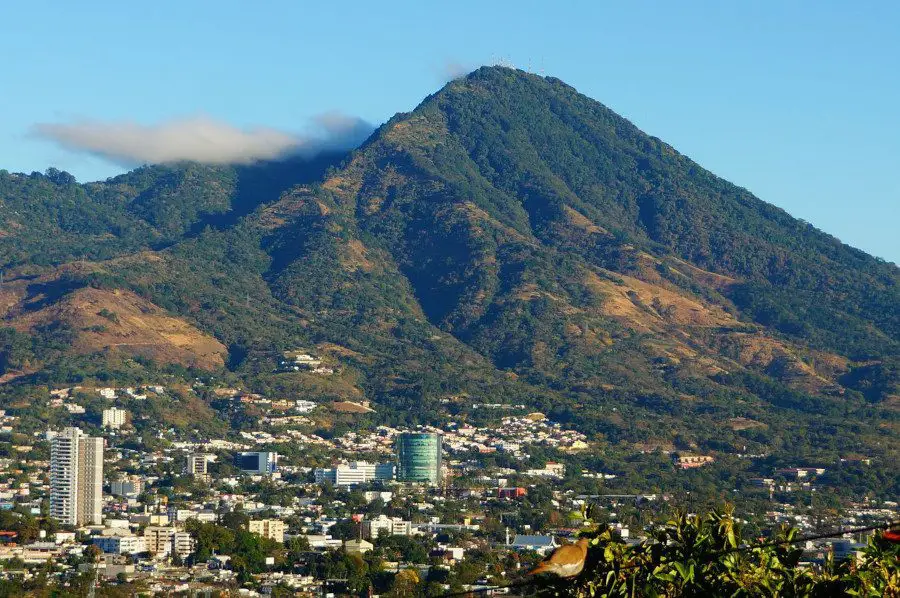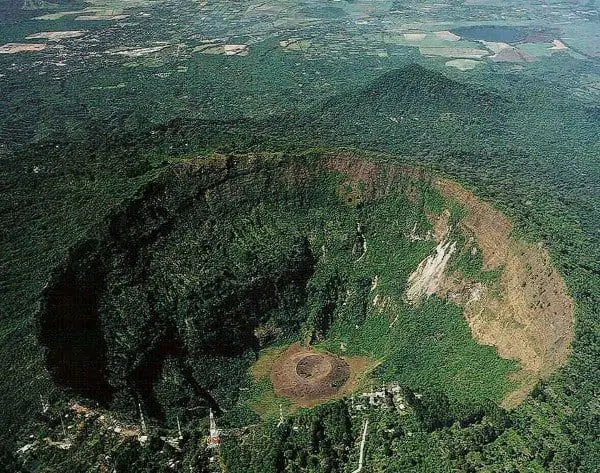
The San Salvador volcano is a stratovolcano located in the northwest part of the capital city. The San Salvador volcano, also known as Quezaltepeque or El Boqueron, covers the municipalities of Quezaltepeque, San Juan Opico, Colon, and Santa Tecla in La Libertad. Also, Nejapa in the department of San Salvador.
This fantastic stratovolcano is one of the most symbolic places in the country. It serves as a backdrop to the Nation’s capital, and it can be seen from any part of San Salvador and the nearby cities.
The slopes of the San Salvador volcano are a big supplier of all kinds of flowers for special holidays and flower delivery services; the families that live in the area continue to maintain the tradition of these crops.
SEE ALSO: El Salvador Tourism: A Journey Through Pristine Beaches, Colorful Towns, and Enchanting Parks
History and information of the San Salvador Volcano.
The San Salvador volcano complex has two main summits. The first is El Picacho, which is the highest point at an elevation of over 1,900 meters.
The second summit is El Boqueron; this is the most popular as it has the El Boqueron national park and the famous craters, El Boqueron and El Boqueroncito.

SEE ALSO: El Salvador’s Ecotourism. 10 Incredible Salvadoran Natural Parks Worth Exploring!
Around the two prominent peaks, there are other inactive craters such as El Jabali, La Joya, Puerta la Laguna, and El Playon, to name a few.
The San Salvador volcano eruption.
According to historians, this volcano, over its history, has had some significant eruptions. These volcanic eruptions are a big part of the history of El Salvador.
For example, the Loma Caldera eruption buried the ancient village of Ceren. The Village of Ceren is today one of the best archaeological sites in the country.
The eruption of El Playon from 1658 to 1671 buried the town of Nexapa. The inhabitants relocated to what is now Nejapa. In this town, the volcanic eruption is remembered and celebrated annually with the balls of fire festival. This unique festival is a must-see in El Salvador.
The 1917 eruption created El Boqueron, one of the best attractions of the volcano. This eruption caused the crater lake located at the summit to evaporate. It formed the big opening that is now El Boqueron.
The lake’s evaporation gave way to a smaller cinder cone inside the giant crater, christened Boqueroncito.
SEE ALSO: Top 15 things to do in San Salvador, the capital city of El Salvador
El Boqueron and El Boqueroncito.
The giant crater located at the second tallest peak of the volcano is El Boqueron, which translates to “big mouth” in Spanish. This volcano crater is 1.5 kilometers in diameter and 500 meters deep.
The El Boqueron crater had a volcanic lake that evaporated in the 1917 eruption. The water evaporation allowed the El Boqueroncito crater to be visible.

Name of the Volcano.
The San Salvador volcano is also known as Quezaltepec or Quezaltepeque; this name in the Nahuatl language translates to the quetzals’ hill.
Quetzals’ Hill sounds beautiful. However, historians Jorge Larde and Larin asserted that such a name was an invention of colonel and lawyer Manuel Fernandez. According to Larin, the Nahuatl term was invented by Fernandez for his work Physical, political, and historical sketch of the Republic of El Salvador in 1869.
The Nahuatl term quetzals’ hill does not appear in any other historical document. Therefore, the Salvadoran academia emphasizes that this volcano has always existed with this name, San Salvador.
Tourism in the San Salvador Volcano.
The San Salvador volcano is a top tourist destination in the country, mainly the area that has El Boqueron National Park. The following are some of the top tourist areas at the San Salvador volcano.
El Boqueron National Park.
The El Boqueron National Park is by far the main attraction. This park has marked trails and is well maintained. Also, getting to the summit and viewing the two volcano craters, which are the main attractions, is not that difficult.
In summary, El Boqueron hill has been developed as the principal tourist attraction at the volcano. Here, visitors can enjoy fresher air, view the beautiful flora and fauna, and view the great craters. Visit our El Boqueron National Park page if you want to know more.
El Playon lava fields.
El Playon lava fields are part of the San Salvador volcanic area. A visit to these fields is for those that are more adventurous. It can be especially interesting for nature lovers.
This extensive surface is covered with gray and black volcanic rocks left from the San Salvador Volcano’s great eruption in 1917. In these volcanic lava patches, you can take walks and discover the biodiversity of the place.

El Picacho summit.
EL Picacho summit is the volcano’s highest point; it sits at over 1900 meters above sea level. This peak can be hiked; however, it is more problematic as it has no well-marked trails or official trails by that matter.
Hiking to the summit of El Picacho is for those who like the wilderness and don’t mind rough terrain. From the top of this volcanic hill, you will get amazing views of the Nation’s capital, along with the Ilopango lake and surrounding areas.
The top of El Picacho is marked by a cement block underneath one of the many radio and television antenna towers.
The San Salvador volcano.
The San Salvador volcano appears as a beautiful natural barrier to the Nation’s capital. The stratovolcano is popular with anyone looking to breathe fresh air and looking to get away from the busy cities’ hustle.




